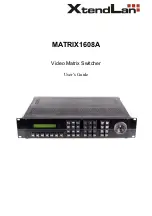
F-2
ForeThought PNNI
F.1
FT-PNNI Routing
The FT-PNNI routing protocol serves to distribute topology and address
reachability information between switches and groups of switches in a net-
work. This topology and addressing information is used by switches to com-
pute paths through the network. FT-PNNI routing has the following aspects:
• Hello Protocol
• Topology Database Exchange
• Flooding
• Hierarchical Routing
F.1.1
Hello Protocol
At regular intervals, each switch transmits a hello indication on each of its
FT-PNNI routing channels. The time between these hello indications is called
the Hello Indication Interval. When a switch receives a hello indication from
one of its neighbors, it initializes the logical link (loglink) from that neighbor
to itself in the topology database.
Since hello indications are sent periodically, loglinks are also refreshed peri-
odically. Note that loglinks discovered as a result of hello indications are uni-
directional. Each switch initializes unidirectional loglinks that have an
adjacent switch as the destination.
F.1.2
Topology Database Exchange
At regular intervals, called the NSAP map indication interval, each switch
sends to each of its neighbors a group of loglinks taken from its topology
database. This is done to ensure that the topology databases of the switches
stay synchronized.
F.1.3
Flooding
Whenever a new loglink is discovered by a switch, the switch immediately
broadcasts the existence of this link to all of its neighbors. The neighboring
switches then broadcast the existence of the same link to all of their neigh-
bors. Very quickly, the existence of the new loglink is flooded immediately to
all of the switches in the network.
Similarly, when a link goes down, that information is propagated through the
network immediately. Also, when a significant change is seen in the metrics of
a loglink, the latest state of the loglink is propagated immediately throughout
the network.
Summary of Contents for MMAC-Plus SFCS-1000
Page 1: ...ATM Switch Configuration Manual...
Page 2: ......
Page 6: ...Notice iv...
Page 22: ...xx PREFACE...
Page 50: ...1 28 Configuring PVCs...
Page 72: ...2 22 Configuring a Classical IP ATM Network...
Page 120: ...5 12 DS 3 Configuration...
Page 130: ...6 10 E 3 Configuration...
Page 326: ...C 22 AMI Operation Commands...
Page 360: ...D 34 AMI Statistics Commands...
Page 382: ...F 10 ForeThought PNNI...
Page 404: ...g 22 GLOSSARY...
















































